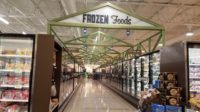Frozen food sales rose significantly the final week of April, according to new research by the American Frozen Food Institute (AFFI), 210 Analytics, and IRI. The +50.3% increase was the highest since the height of mid-March stockpiling by consumers, when frozen food sales peaked at +94.4% compared to 2019 sales for the same time period. The +50.3% increase translates to $1.3 billion compared to $442 million in 2019.
The AFFI report notes the uptick in overall frozen food sales is driven by perceived meat shortages and subsequent panic buying by consumers. Many stores are limiting fresh meat sales per customer in response, but few limits are on frozen meat products, which resulted in empty shelves at some stores. One consumer surveyed for the current report mentioned going to the store to buy "frozen bags of chicken tenderloins and wings, but there were not available.”
Overall, frozen meat (beef, pork, poultry, seafood) was up +68.0% the final week of April, which is the highest since the two peak stockpiling weeks of March 15 and March 22, when sales were up +97.5% and +123.1%, respectively, compared to 2019.
Specific categories of frozen food rose across the board at the end of April, with frozen meat leading the way (+68.0%). Other areas realizing significant sales gains were:
- Frozen prepared meals (including pizza) = +37.2%, the highest since +99.3% on 3/22.
- Frozen desserts = +45.9%, the highest recorded increase during the pandemic. Subcategories include ice cream at +48.7% and frozen novelties at +44.6%, both the highest since the pandemic started. Dessert toppings showed modest gains at +29.4%, after peaking at +57.2% on 4/12 (a number that still astounds me--who buys that much frozen dessert topping at one time?)
- Frozen fruits and vegetables = +57.6%, the highest since +111.4% on 3/22.
- Frozen snacks and appetizers = +76.0%, the highest since +127.2% on 3/22.
- Frozen beverages = +65.4%, the highest since +142.9% on 3/22.
- Frozen baked goods = +44.0%, the highest since +87.8% on 3/22.
Looking ahead, with the supply chain currently disrupted for meats and other items due to binge buying (watch for a corresponding rise in meat prices too) frozen food sales should continue their record levels compared to 2019 because demand remains high. Also, many states are in different phases of reopening, which will include restaurants and other foodservice outlets in a modified capacity. According to the AFFI, "The reopening of restaurants in these states may provide an indicator of consumers’ mental readiness and economic ability to re-engage with foodservice. The widely covered meat shortages in consumer media caused another surge in meat demand, both fresh and frozen the first week of May, which likely means highly-elevated numbers in next week’s results as well. For the foreseeable future, it is likely that grocery retailing will continue to capture an above-average share of the food dollar."
Click here for more COVID-19 coverage and how it is affecting the refrigerated and frozen foods industry.




